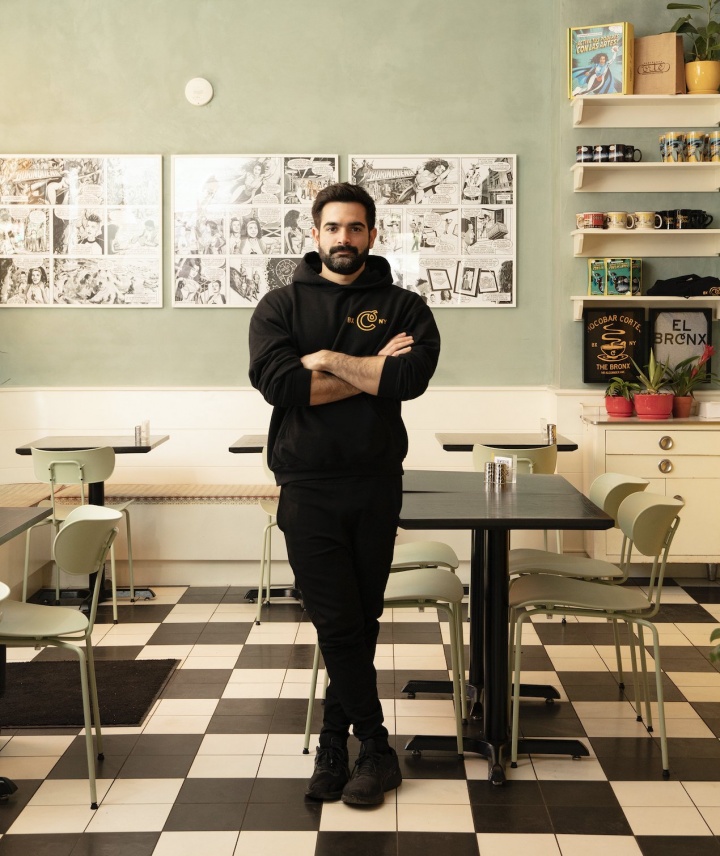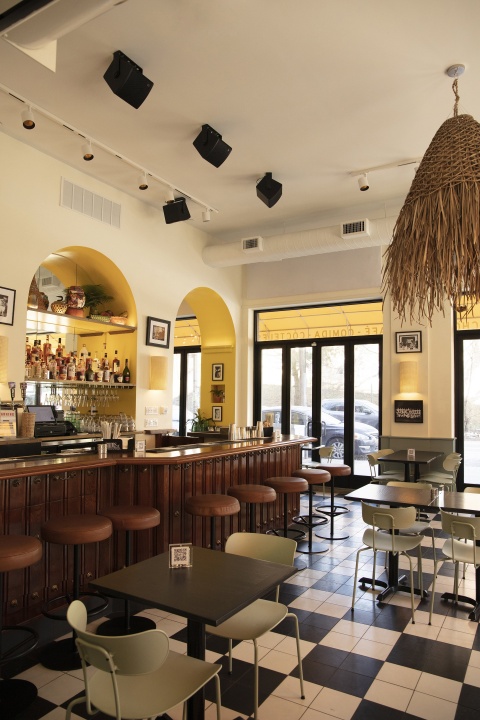A chocolate dynasty debuts in New York.
Columbia College | Columbia University in the City of New York
A chocolate dynasty debuts in New York.

Photographs by Jörg Meyer
The Bronx eatery is an offshoot of the original Chocobar Cortés restaurant in San Juan, opened by Cortés’s mother, Elaine Shehab, in 2013. The NYC location opened in December 2021 to much fanfare: The New York Times described the menu as having “a Willy Wonka giddiness” (fun touches like lighting fixtures made from old chocolate molds add to the charm, as does the bathroom plastered in floor-to-ceiling vintage Chocolate Cortés ads); The New Yorker raved about the chocolate grilled cheese (made with chocolate-infused butter!) and thick Puertorriqueño hot chocolate. Says Cortés, “It’s exciting that people are paying attention to what we’re doing! When I would tell people I was opening a chocolate restaurant in the Bronx, they would be like, ‘What, where?!’ And now they’re understanding.”
The concept for the Bronx outpost had been brewing in Cortés’s mind for several years. After graduating from the College, he started working with one of Chocolate Cortés’s distributors in New York, going to supermarkets where the family’s products were sold and thinking through how they could increase sales and awareness. The experience resulted in an epiphany — he realized they needed to be creative to stand out in a market dominated by giants like Nestlé, Hershey and Mars. While he took some professional detours, studying business and medicine at NYU, the potential to have an impact on NYC called to him.

Chocobar Cortés’s inviting interior.
Chocolate Cortés products are ubiquitous in Puerto Rico and the Dominican Republic; they are especially known for their hot chocolate bar — thick, heavy blocks of rich chocolate made for slowly dissolving down into a warm, melty treat (it also comes in pre-grated varieties for people who don’t want to wait). Cortés says that the brand stirs up nostalgia in the Caribbean community, and his main goal was to bring those feelings to a new generation and a wider audience.
“To go from Puerto Rico and open a restaurant in the middle of a pandemic in the South Bronx is a bold and risky move,” says Cortés. But he saw it not just as an opportunity to branch out the family business, but also as a “necessity” for New York City. “In the Bronx, one out of every two people is Puerto Rican or Dominican, and in New York City it’s nearly one out of every six,” he says. “That’s insane! The contribution of Puerto Ricans and Dominicans to the culture and the DNA of New York City cannot be denied, and yet we do not have enough restaurants and brands and businesses and entrepreneurs that truly do that ratio justice.”
He continues, “My goal wasn’t to be a restaurateur; it was to celebrate our culture, celebrate our chocolate, celebrate my family’s heritage, celebrate our heritage as Puerto Ricans and Dominicans. I want to show our communities that we can have nice spaces and nice things that people can feel proud of. I want to show other entrepreneurs — who maybe don’t have many examples of Latinx businesses that are thriving — that they can be entrepreneurs, too. I want people to see that Puerto Rican and Caribbean cuisine is so much more than rice and beans.”

Cups of warmth on a cold day.
As we dug in to our feast (we also had churros and a guava pastry), for a moment the bleak winter weather and the ongoing stressors of pandemic life faded away, and there was just good food and warm chocolate. Says Cortés, “We want people to be able to sit around and enjoy happy moments with their loved ones. [Our chocolate] is something that brings a lot of comfort to people and it is part of our traditions — that’s what we are trying to preserve.”

Published three times a year by Columbia College for alumni, students, faculty, parents and friends.
Columbia Alumni Center
622 W. 113th St., MC 4530, 6th Fl.
New York, NY 10025
212-851-7852
cct@columbia.edu

Columbia Alumni Center
622 W. 113th St., MC 4530, 4th Fl.
New York, NY 10025
212-851-7488
ccalumni@columbia.edu